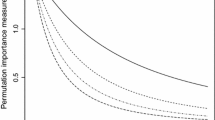Abstract
A common problem in geostatistics is to determine whether or not the value of a random field at an unsampled location exceeds a specified threshold using observed values of the random field at sampled locations. Under the indicator approach, the only information used to classify the unobserved value is whether or not the observed values exceed the threshold. This note shows that the loss of information from applying the indicator approach may be modest in the case where the underlying random field is Gaussian.
Similar content being viewed by others
References
Journel, A. G., 1983, Nonparametric estimation of spatial distributions: Math. Geol., v. 15, p. 445–468.
Rao, C. R., 1973, Linear Statistical Inference and Its Applications: Wiley, New York.
Solow, A. R., 1986, Mapping by simple indicator kriging: Math. Geol., v. 18, p. 335–352.
Solow, A. R., 1991, A method for approximating multivariate normal orthant probabilities: J. Stat. Comp. Simulat., v. 37, p. 225–229.
Switzer, p., 1977, Estimation of spatial distributions from point sources with application to air pollution measurement: Bull. Int. Stat. Inst., v. 47, p. 123–137.
Author information
Authors and Affiliations
Rights and permissions
About this article
Cite this article
Solow, A.R. On the efficiency of the indicator approach in geostatistics. Math Geol 25, 53–57 (1993). https://doi.org/10.1007/BF00890675
Received:
Accepted:
Issue Date:
DOI: https://doi.org/10.1007/BF00890675




